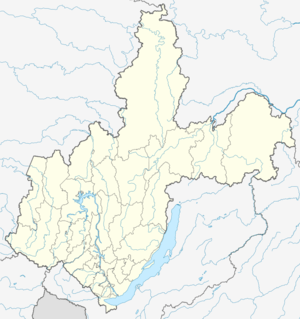Belaya (air base)
Belaya (ICAO: UIIB) is a significant Long Range Aviation base in Usolsky District, Irkutsk Oblast, Russia located 18 kilometres (11 mi) north of Usolye-Sibirskoye and 85 kilometres (53 mi) northwest of Irkutsk. From 2009 it has sometimes been known as Srednii. It has significant ramp space and 38 bomber revetments.
Belaya  | |||||||||||
|---|---|---|---|---|---|---|---|---|---|---|---|
 | |||||||||||
| Summary | |||||||||||
| Airport type | Military | ||||||||||
| Owner | Ministry of Defence | ||||||||||
| Operator | Long Range Aviation, Russian Air Force | ||||||||||
| Location | Usolye-Sibirskoye, Russia | ||||||||||
| Elevation AMSL | 458 m / 1,503 ft | ||||||||||
| Coordinates | 52°54′54″N 103°34′30″E | ||||||||||
| Map | |||||||||||
 Belaya Air Base Location in Irkutsk Oblast | |||||||||||
| Runways | |||||||||||
| |||||||||||
The base's bomber fleet, consisting at various times of Tu-16, Tu-22, and Tu-22M aircraft, played a considerable role in Asian strategy. The base was especially important in projecting power against the People's Republic of China following the Sino-Soviet split of the late 1960s.
Station history
An air defense unit, the 350th Fighter Aviation Regiment PVO (Military Unit: 65319), arrived at Belaya in 1946 or 1950 and was equipped with the MiG-17, 1955-1962, the Su-9, 1961-1967, and the Tupolev Tu-128 (Fiddler) from 1967.
In 1954 Belaya was used as a staging base for Tupolev Tu-4 aircraft sent to China to observe American fusion bomb tests in the Pacific, but the runway was unpaved at this time.[1] Sometime around the late 1950s the airfield was upgraded and its received the nuclear bomber missions starting during the late 1960s.
By 1982 Western intelligence showed that Belaya supported two Tu-22M2 Backfire-B regiments subordinate to the Irkutsk Air Army, and a PVO air defense Tu-128 Fiddler regiment subordinate to the Novosibirsk Air Defense District.[2]
In 1984 the air defense regiment moved to Bratsk Airport.[3] It was in succession part of the 26th Air Defence Division, the 39th Air Defence Corps, and the 54th Air Defence Corps. However, the bomber regiments remained.
Units stationed at Belaya 1945-1994 included:
- 1225 TBAP (1225th Heavy Bomber Aviation Regiment) flying Tupolev Tu-4 aircraft in 1956-1958 and upgrading to Tupolev Tu-16 in 1958 and Tupolev Tu-16K in 1961. It began flying the Tupolev Tu-22M2 starting in 1982 and retained this aircraft through at least the 1990s.[4][5] Disbanded 1994.[6]
- 1229 TBAP (1229th Heavy Bomber Aviation Regiment) flying the same aircraft and receiving the same upgrades at the same times as 1225 TBAP. Disbanded 1994.[7]
U.S. national agencies may also have listed the 1339th Heavy Bomber Aviation Regiment (1339th TBAP) flying Tupolev Tu-16 bombers at the base during the Cold War. No Russian sources appear to list this regiment.
As the 1225 and 1229 TBAPs were disbanding in 1994, the 200th Guards Brestskiy Red Banner order of Suvorov Heavy Bomber Aviation Regiment appears to have been arriving from Bobruisk, Mogilev Oblast, by that time part of Belarus. The 200th Guard TBAP had been at Bobruisk since May 1946.[8] Once it arrived at Belaya, it came under the control of the 326th Heavy Bomber Aviation Division. As of 2006, Google Earth imagery showed a total of 26 Tupolev Tu-22M medium-range bombers visible in revetments, increasing to 36 as of 2018.[9]
On 1 December 2009, the 200th Guards TBAP was reorganized as the 6953rd Guards Airbase, which later, in December 2010 reformed as an Air Group of the 6952nd Guards Air Base (Ukrainka).
References
- "Pages from a diary of the Colonel Strunova Peter Vladimirovicha's resignation". Airforce.ru.
- National Photographic Interpretation Center, Z-10604/82, NPIC/PEG 4/82, via Central Intelligence Agency CREST.
- "350th Fighter Aviation Regiment PVO". Ww2.dk. Retrieved 2019-01-26.
- "Dal'nyaya Aviatsiya". Aviabaza KPOI.
- "Take-OffF". take-off.ru.
- "1225th Heavy Bomber Aviation Regiment". Ww2.dk. Retrieved 2019-01-26.
- "1229th Heavy Bomber Aviation Regiment". Ww2.dk. Retrieved 2019-01-26.
- "200th Guards Heavy Bomber Aviation Regiment". Ww2.dk. Retrieved 2019-01-26.
- "Google Maps". Google Maps. Retrieved 26 January 2019.
| Wikimedia Commons has media related to Belaya (air base). |